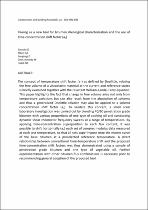 ResearchSpace
ResearchSpace
Fluxing as a new tool for bitumen rheological characterization and the use of time-concentration shift factor (ac)
JavaScript is disabled for your browser. Some features of this site may not work without it.
- ResearchSpace
- →
- Research Publications/Outputs
- →
- Journal Articles
- →
- View Item
| dc.contributor.author |
Zoorob, SE

|
|
| dc.contributor.author |
Mturi, George AJ

|
|
| dc.contributor.author |
Sangiorgi, C

|
|
| dc.contributor.author |
Dinis-Almeida, M

|
|
| dc.contributor.author |
Habib, NZ

|
|
| dc.date.accessioned | 2017-11-10T10:00:24Z | |
| dc.date.available | 2017-11-10T10:00:24Z | |
| dc.date.issued | 2018-01 | |
| dc.identifier.citation | Zoorob, S.E. et al. Fluxing as a new tool for bitumen rheological characterization and the use of time-concentration shift factor (ac). Construction and Building Materials, vol. 158: 691-699 | en_US |
| dc.identifier.issn | 0950-0618 | |
| dc.identifier.uri | http://www.sciencedirect.com/science/article/pii/S0950061817320500 | |
| dc.identifier.uri | https://doi.org/10.1016/j.conbuildmat.2017.10.020 | |
| dc.identifier.uri | http://hdl.handle.net/10204/9762 | |
| dc.description | Copyright: 2017 Elsevier. Due to copyright restrictions, the attached PDF file only contains the abstract of the full text item. For access to the full text item, please consult the publisher's website. | en_US |
| dc.description.abstract | he concept of temperature shift factor (aT) as defined by Doolittle, relating the free volume of a viscoelastic material at the current and reference states is briefly examined together with the resultant William-Landel-Ferry equation. This paper highlights the fact that change in free volume arise not only from temperature variations but can also result from the absorption of solvents and thus a generalized Doolittle relation may also be applied to a solvent concentration shift factor (ac). To validate this concept, a small scale laboratory investigation was carried out by blending 40/60 penetration grade bitumen with various proportions of one type of cooking oil and conducting dynamic shear rheometer frequency sweeps at a range of temperatures. By applying time-concentration superposition to each flux content, it was possible to shift horizontally (ac) each set of complex modulus data measured at each test temperature, so that all sets superimpose onto the master curve of the base bitumen at a preselected reference temperature. A direct relationship between conventional time-temperature shift and the proposed time-concentration shift factors was thus demonstrated using a sample of penetration grade bitumen and one type of vegetable oil. Further experimentation with other bitumen-flux combinations is necessary prior to recommending general adoption of the proposed tool. | en_US |
| dc.language.iso | es | en_US |
| dc.publisher | Elsevier | en_US |
| dc.relation.ispartofseries | Worklist;19688 | |
| dc.subject | Bitumen rheological characterization | en_US |
| dc.subject | Bitumen fluxing | en_US |
| dc.subject | Free volume shifting | en_US |
| dc.subject | Time-concentration superposition | en_US |
| dc.subject | Time-temperature superposition | en_US |
| dc.title | Fluxing as a new tool for bitumen rheological characterization and the use of time-concentration shift factor (ac) | en_US |
| dc.type | Article | en_US |
| dc.identifier.apacitation | Zoorob, S., Mturi, G. A., Sangiorgi, C., Dinis-Almeida, M., & Habib, N. (2018). Fluxing as a new tool for bitumen rheological characterization and the use of time-concentration shift factor (ac). http://hdl.handle.net/10204/9762 | en_ZA |
| dc.identifier.chicagocitation | Zoorob, SE, George AJ Mturi, C Sangiorgi, M Dinis-Almeida, and NZ Habib "Fluxing as a new tool for bitumen rheological characterization and the use of time-concentration shift factor (ac)." (2018) http://hdl.handle.net/10204/9762 | en_ZA |
| dc.identifier.vancouvercitation | Zoorob S, Mturi GA, Sangiorgi C, Dinis-Almeida M, Habib N. Fluxing as a new tool for bitumen rheological characterization and the use of time-concentration shift factor (ac). 2018; http://hdl.handle.net/10204/9762. | en_ZA |
| dc.identifier.ris | TY - Article AU - Zoorob, SE AU - Mturi, George AJ AU - Sangiorgi, C AU - Dinis-Almeida, M AU - Habib, NZ AB - he concept of temperature shift factor (aT) as defined by Doolittle, relating the free volume of a viscoelastic material at the current and reference states is briefly examined together with the resultant William-Landel-Ferry equation. This paper highlights the fact that change in free volume arise not only from temperature variations but can also result from the absorption of solvents and thus a generalized Doolittle relation may also be applied to a solvent concentration shift factor (ac). To validate this concept, a small scale laboratory investigation was carried out by blending 40/60 penetration grade bitumen with various proportions of one type of cooking oil and conducting dynamic shear rheometer frequency sweeps at a range of temperatures. By applying time-concentration superposition to each flux content, it was possible to shift horizontally (ac) each set of complex modulus data measured at each test temperature, so that all sets superimpose onto the master curve of the base bitumen at a preselected reference temperature. A direct relationship between conventional time-temperature shift and the proposed time-concentration shift factors was thus demonstrated using a sample of penetration grade bitumen and one type of vegetable oil. Further experimentation with other bitumen-flux combinations is necessary prior to recommending general adoption of the proposed tool. DA - 2018-01 DB - ResearchSpace DP - CSIR KW - Bitumen rheological characterization KW - Bitumen fluxing KW - Free volume shifting KW - Time-concentration superposition KW - Time-temperature superposition LK - https://researchspace.csir.co.za PY - 2018 SM - 0950-0618 T1 - Fluxing as a new tool for bitumen rheological characterization and the use of time-concentration shift factor (ac) TI - Fluxing as a new tool for bitumen rheological characterization and the use of time-concentration shift factor (ac) UR - http://hdl.handle.net/10204/9762 ER - | en_ZA |





